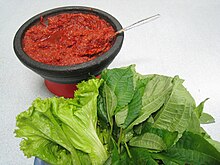|
Lalab
Lalap or lalab is a side-dish (uncooked fruit, leaves etc eaten with the rice).[1] There are no set rules on what vegetables make into lalab; in practice, all edible vegetables can be into lalab. However, the most common raw vegetables are cucumber, tomato, cabbage, lettuce, lemon basil, leunca, and long beans. While the blanched or boiled vegetables may include spinach, papaya leaves, and chayote. The dressing for this salad is usually sambal terasi, served directly from the stone mortar as a spicy dipping sauce for these assorted raw vegetables. Today, lalab is popular throughout Indonesia. It is usually served as a vegetable side dish next to the main course, such as ayam goreng (fried chicken), ayam bakar (grilled chicken), pepes, pecel lele (fried catfish), fried gourami, and many other ikan goreng (fried fish) or ikan bakar (grilled fish). HistoryLalap or lalab is recorded in the Jeru-Jeru Inscription dated 930 AD and the Taji Inscription dated 910 AD during the Medang Kingdom (Ancient Mataram).[2] The word "lalap" (a variant of "lalab") comes from the Modern Javanese "lalap" which is derived from the Old Javanese "lalab" 'side-dish (uncooked fruit, leaves etc eaten with the rice)'.[3] Ingredients Originally, it was made from any available edible young leaves and raw vegetables known by Sundanese since ancient times. Today, though, most lalab consists of sliced cabbage, cucumbers, lettuce, green beans, yardlong beans, tomatoes, leunca, lemon basil, spinach, water spinach, pohpohan leaves (Pilea melastomoides), kenikir leaves (cosmos), cassava leaves, papaya leaves, chayote, and small, green eggplant. Sometimes, other exotic vegetables also are used, such as green, stinky petai, and jengkol beans.[4] Although most lalab vegetables are only washed in cold water and served raw, some boiled, steamed, and fried variations are also available; for example, petai green beans can be served either raw or fried, while labu siam (chayote), water spinach, and cassava leaves are usually served boiled. While most vegetables are served raw or simply boiled or blanched, the main flavouring agent is its dressing, the hot and spicy sambal terasi which is chili paste in terasi shrimp paste. Most of recipes revolved around specific recipe of sambals.[5] Nutrients In Indonesian cuisine, lalab often served as garnishing or as vegetable accompaniment to the main meal of fish or chicken; such as ayam goreng (fried chicken) or pecel lele (fried catfish). Lalab is rich in vitamins, minerals and fiber. Daily consumption of fresh vegetables is good for reducing cholesterol levels and improving digestive health. Vegetables are also rich in antioxidants, which contribute to fighting free radicals, and have antiaging and anticancer properties. Several plants used in lalab also are believed to have certain medicinal properties.[6] See also
References
External linksWikimedia Commons has media related to Lalab. |
||||||||||||||||||||
Portal di Ensiklopedia Dunia
